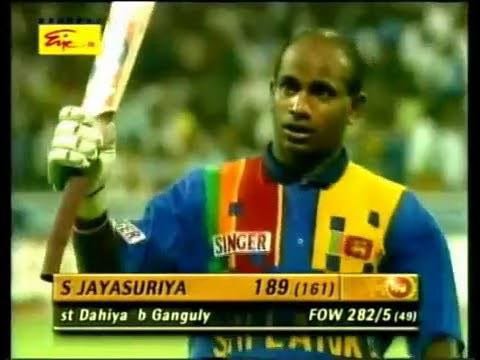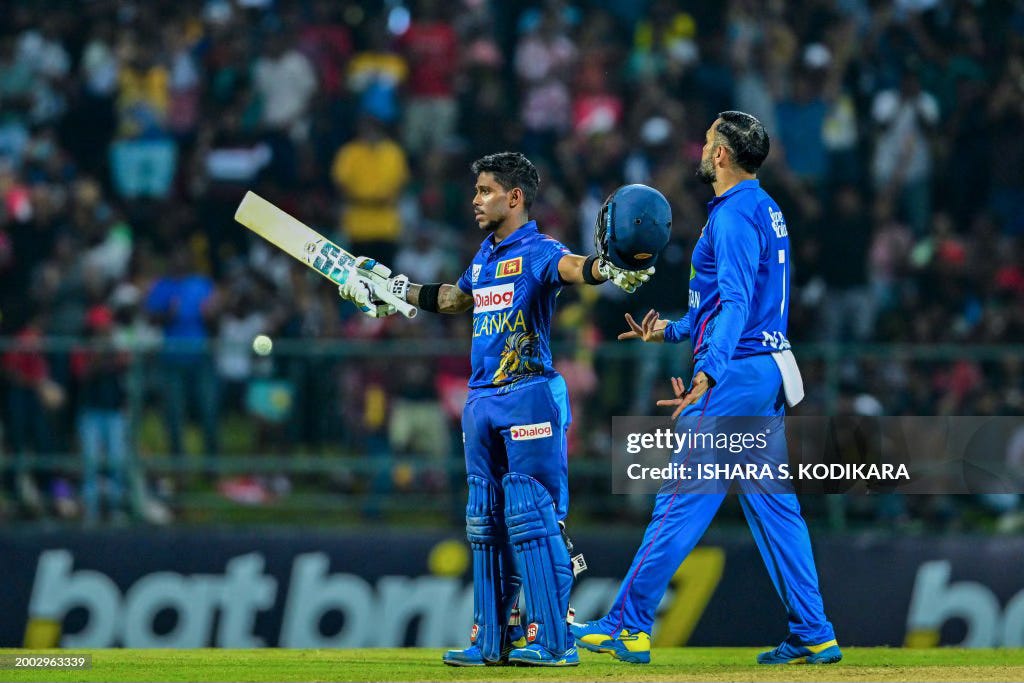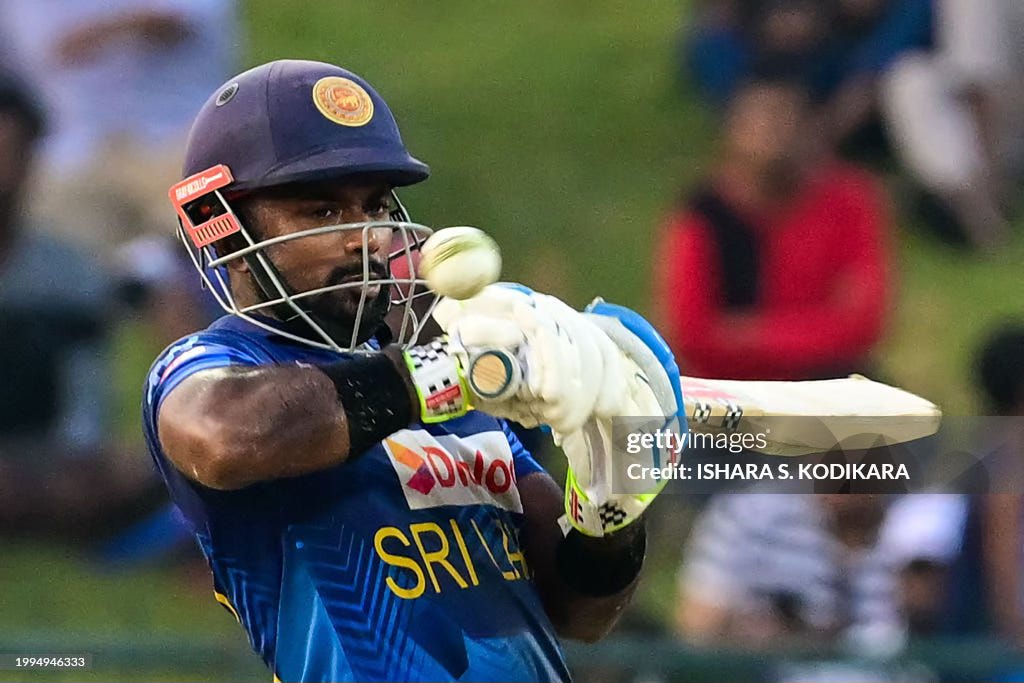Pathum goes into the history books & a look back at Sanath's 189
We also discuss the takeaways from the Sri Lanka v Afghanistan ODI series
The Sorcery of the Matara ‘Master Blaster’
by Nick Brookes
‘I have not seen Don Bradman bat, but I have seen Sanath Jayasuriya. I have not seen a better batsman in my cricketing career.’
In cricketing circles, endorsements don’t come much higher; when sticking a reference on your CV, few names carry as much weight as Sachin Tendulkar’s.
As the millennium neared, the whole cricket world was in awe of Matara’s ‘Master Blaster’ – though it’s fair to say that India’s cricketers’ respect was laced with fear and trepidation. He’d already ended Manoj Prabhakar’s career; a week after Tendulkar’s praise, Ajay Jadeja pretended to perform black magic on the outfield during a Jayasuriya innings. It was a joke with serious undertones – this India team had no idea how to get Sanath out.
During the summer of 1997, Jayasuriya terrorised India. In May, he went to the Wankhede and slammed 151* off 120. A couple of months later, he blasted 63 off 52 in the Asia Cup Final. Then there was that famous Test series: 340 in the first Test, a breakneck 199 in the second. As if he hadn’t done enough damage, he followed up with 73 off 52, 66 off 56 and 68 off 38 in the ODIs. All that at a time when 230 was a par score. India knew plenty about Sanath Jayasuriya.
But knowing and stopping are two very different things. As Sanath lent on a cover drive – sending the first ball of the 2000 Coca-Cola Champions Trophy racing to the cover boundary, there must have been furrowed brows and anxious sighs. He was at it again.
There was assistance on offer for the seamers – bounce and a little bit of swing, yet Jayasuriya played without fear. In the early goings, his placement was as impressive as his power. There were nudges to the third-man fence and clips that raced past short fine-leg. When width was on offer, he threw the kitchen sink at the ball. Ganguly tried to outfox him with close catchers on the leg side, but Sanath pulled powerfully over their heads. As he raised his bat to mark a half-century, you sensed it would be his day.
But, the other batters were finding life less straightforward. Kaluwitharana, Atapattu, Jayawardene and Sangakkara came and went – at 116-4 in the 28th, Sri Lanka were in trouble. At one stage, they went 13 overs without a boundary, but as the Lankans entered their final 20, Sanath sparked back into life.
He reached 100 off 118 balls: with Russel Arnold providing support, Sanath tore into the Indian bowlers. The seamers received especially brutal treatment – whenever they pitched short, the ball flew to the boundary; when Agarkar overcompensated he was clipped over the ropes and carved away square. Jayasuriya looked nonplussed as he went past 150; clearly, he wasn’t done yet.

He discarded his helmet for the final few overs: as India grew ragged, Jayasuriya kept on peppering the leg-side fence. It felt it would take something special – or strange – to dislodge him, and so it proved. Ganguly introduced himself in the 49th; after being greeted with a punishing slap, he had Sanath stumped stretching for a wide.
With 189 off 161, he had gone past Lara for the highest score at Sharjah, and equalled Viv Richards for the second-highest ODI score of all time. Saeed Anwar’s record was just five runs away – yet, that mattered little. Sanath seemed more concerned with doling out punishment than putting records in the books. His last 89 had come off 43 – once again, Jayasuriya had shown himself to be unique. No other batter of the era combined hunger for runs and destructive impulses so effectively. Through these years, he was worth his weight in gold.
The full impact of his innings was emphatically forced home as Vaas steamrolled India’s top order. Ganguly, Tendulkar, Yuvraj and Kambli were all sent packing for single-figure scores; Murali mopped up the tail, as India were skittled for 54. At this stage, no team had lost by as much as 245; Jayasuriya’s blast had sapped the spirit out of India. Staring up at a mountainous score, Ganguly’s men had got stuck at base camp.
But unfortunately, what goes around comes around. Three times last year – at Thiruvananthapuram, Khettarama and the Wankhede – India beat Sri Lanka by monstrous margins. The sorcery which Sanath wrought for so long has fallen into the wrong hands; now, it’s Bumrah, Siraj and Shami who cast spells that make the whole of Sri Lanka shudder.
But it won’t always be this way. Looking back at one of Sanath’s finest ODI innings reminds us about the destructive power of big runs. No one expected Nissanka to become Sri Lanka’s first ODI double-centurion: hopefully, the achievement will spur him and his teammates on. If the top six can learn to truly gorge themselves, to bat with the hunger that sometimes seems to have gone missing, they’ll give their bowlers a real shot in the arm.
Sri Lanka might just go back to steamrolling sides – and isn’t that something we’d all like to see?
Nissanka takes his place in the history books
by Mark Machado
Pathum Nissanka's inclusion as a multi-format batter into Sri Lanka's squad for the tour of the West Indies in early 2021 came as a bit of surprise. It wasn't that keen followers of Cricket on the island weren't aware of Pathum or his burgeoning batting talent, it was that selecting him in the T20 squad seemed a little bit rogue considering he'd failed to get selected for the inaugural Lanka Premier League which had taken place only weeks before the squad was announced.
The boy from Kalutara's talents were well known by 2021, his exploits firstly for Kalutara Vidyalaya and then Isipathana College got him selected for National U19's honours against a touring South Africa side.
An orthodox batter who relies on timing over power to find the boundary, Pathum is fast becoming one of the more reliable players on the white ball team sheet. Since he has come into the side, fans have seen him go from inexperienced and undercooked rookie to steady hand to what we have seen during the Afghanistan series: an explosive opening batter.
The son of a Groundsman, Sri Lanka were ODI World Champions when he was born and reports suggest the first player he grew up idolising was Sanath Jayasuriya. A man whose record he would break, when he scored 210* against Afghanistan in the first ODI. Three years into his international career and his record compares favourably against that of Sanath's, though I would say in Sanath's defence that he did come into the side as a bowler and in not a great period for Sri Lankan Cricket in terms of results.
It's fairly unusual in Sri Lankan cricket for players to come straight into the side as opening batters, only Upul Tharanga has done it in recent times and the stats suggest that Nissanka is more successful at acquiring runs then Upul was at this stage of his career.

Pathum's recent showing with the bat, which has done wonders for his average and strike rate would have come as great relief to selectors as his inclusion in shorter formats of the game was starting to be criticised by some on social media, especially with him not being included in red ball squads when many felt that was the format his game most naturally fitted.
The 210 against Afghanistan guarantees Pathum's place in the history of Sri Lankan cricket. In a period when ODI cricket is in global decline, it's sensational that Nissanka has become the first Sri Lankan player to score a double century in the format. It's also testament to what Sri Lankan players can do when they have full and unconditional support from management and I think it's significant that the player at the other end with him was Aviskha Fernando, a player whose confidence has suffered tremendously over the years due to management indecision over his role in the side.
If Pathum can stay injury free, it's possible to envisage him making big scores for well over the next 10 years and hopefully he does.
Takeaways from the Afghanistan ODI Series
1) Finally, some good pitches
In the recently completed World Cup, Sri Lanka struggled to adjust to conditions. The ICC/BCCI eschewed the standard slow, low decks native to the subcontinent, opting instead for more “sporting” pitches. The result was extremely batting friendly conditions in which the par score was usually 350 or more. Sri Lankan batters, brought up in pitches where 280 is a good score, proved unable to consistently produce the high octane performances needed to score in excess of 300. Likewise, Sri Lankan bowlers struggled to take wickets on these placid surfaces.
SLC, it seems, finally got the memo. Not only were the pitches for the recently concluded one-day series perfect for batting, but the leadership of the team made sure to discuss the importance of playing on these pitches. Chris Silverwood, in one of his pre-match press conferences, said he believes that the side is better suited for good pitches than they are for slower pitches. Both Kusal Mendis and Charith Asalanka mentioned that they had asked ground staff to prepare good wickets to help them prepare for the 2027 World Cup.
Indeed, if this team is to challenge for a semi-final berth in South Africa, they will need to learn how to chase big totals, how to take wickets in unhelpful conditions, and how to take games deep. And the only way they can do that is by playing consistently on flat wickets. Here’s to hoping SLC persists with this change.
2) A settled top 5
Lost in Pathum Nissanka’s stellar series was just how good the rest of the top order was. Avishka Fernando, coming off a very ordinary series against Zimbabwe, was brilliant. Yes, the substance — the intent and execution — of his innings impressed, but how about his style. Anytime an Afghan bowler erred on the legside, he dispatched them into the night sky with a thunderous crack of the bat. If he keeps batting like this, it will be hard to keep him out of the T20 squad.
Just as good, if not quite as stylish, was Charith Asalanka. In fact, Asalanka technically had a highest average of any Sri Lankan batter in the series by virtue of not being dismissed the entire series. Asalanka’s 97 from 74 in the second ODI was lower middle order batting at its finest; there was the steady rebuild after the fall of successive wickets, the smart runnings for ones and two to keep the scoreboard ticking, and the explosive acceleration in the final 10. Though he has played some crucial knocks in Lankan chases, this innings was one of the first times that Asalanka helped to power Sri Lanka to a big score while batting first.
Kusal Mendis and Sadeera Samarawickrama were not as prolific as the other members of the top 5, but both played their roles very well. Mendis and Sadeera rebuilt after the loss of early wickets in the second ODI, putting a 100-run partnership that put Sri Lanka on course for a big score. Both played a good hand in support of Pathum Nissanka, with Sadeera scoring a 45 off 36 in the first ODI and Mendis bashing to 40 off 29 in the third.
The significant contributions of the top 5 in this series bode well for the future, a future that will heavily depend on these players converting their potential into consistency.

3) Sri Lankan Swagger?
By defeating Afghanistan 3-0, Sri Lanka swept its first ODI series in almost four years. One would have to go back to 2020 to find a similar scoreline, a 3-0 blanking of the West Indies. But I think that you really have to go further back to find a series in which Sri Lanka so thoroughly outclassed its opposition. The West Indies series in 2020 was much closer than the scoreline suggested. The Lankans won the first ODI by one wicket and squeaked by the Windies by just 6 runs in the third and final match.
A number of Sri Lankan players had dominant series. Pathum, Avishka, and Charith all had their way with the Afghan bowlers, while the Afghan batters seriously struggled with Wanindu Hasaranga, Maheesh Theekshana, and Pramod Madushan.
But beyond these dominant performances, the Lankans also saw themselves out of tough situations. In the second ODI, they stitched together three crucial partnerships to stave off some impressive bowling from Afghanistan. In all three matches, the bowlers managed to find a way to take a wicket when a partnership threatened to tilt the game in favor of Afghanistan. These wickets proved match-defining, as they produced major collapses in the second and third ODIs and stemmed the flow of runs in the first.
It has been a while since a Lankan one-day side has put on this kind of quality performance. Maybe since 2014? Yes, it was against a weakened Afghanistan squad, but we might as well ask what everyone is thinking: are these the first signs of a Sri Lankan white-ball renaissance?



